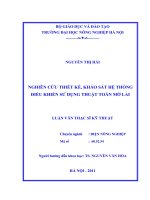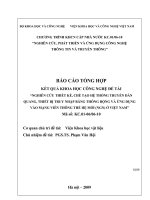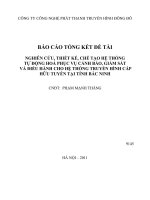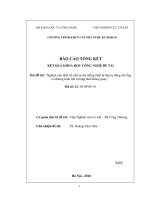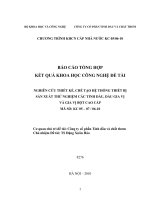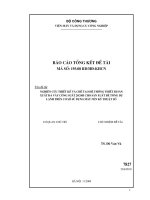Nghiên cứu thiết kế sử dụng hệ thống năng lượng mặt trời
Bạn đang xem bản rút gọn của tài liệu. Xem và tải ngay bản đầy đủ của tài liệu tại đây (1.76 MB, 82 trang )
..
MINISTRY OF EDUCATION AND TRAINING
HANOI UNIVERSITY OF SCIENCE AND TECHNOLOGY
PAULINO VICTORINO RODRIGUES MUEBE
STUDY AND DESIGN OF A SOLAR PV SYSTEM
MASTER OF SCIENCE
HANOI 2016
MINISTRY OF EDUCATION AND TRAINING
HANOI UNIVERSITY OF SCIENCE AND TECHNOLOGY
---------------------------------------
PAULINO VICTORINO RODRIGUES MUEBE
STUDY AND DESIGN OF A SOLAR PV SYSTEM
CONTROL AND AUTOMATION
MASTER THESIS IN SCIENCE
SCIENTIFIC SUPERVISOR:
ASSOC. PROF. TA CAO MINH, PhD.
.
HANOI 2016
Contents
Declaration ................................................................................................................ iii
List of Figures ........................................................................................................... iv
List of Tables............................................................................................................ vii
List of Acronyms ..................................................................................................... viii
Acknowledgement ..................................................................................................... ix
Dedication ...................................................................................................................x
ABSTRACT .............................................................................................................. xi
1
CHAPTER I - INTRODUCTION ....................................................................2
1.1
Generalities ....................................................................................................2
1.2
Renewable energy..........................................................................................3
1.2.1
The solar panel ....................................................................................4
1.2.2
Typical configuration of a PV system ...............................................10
1.2.3
Main applications ..............................................................................11
1.2.4
Configuration of a 150W PV stand-alone system .............................11
Conclusions of Chapter 1.......................................................................................11
2
CHAPTER II - SYSTEM SIZING .................................................................13
Conclusions of Chapter 2.......................................................................................16
3
CHAPTER III - SYSTEM CONTROL ..........................................................18
3.1
Charge controller .........................................................................................18
3.1.1
Buck converter modelling .................................................................19
3.1.2
Charger modelling .............................................................................21
3.2
Inverter Control ...........................................................................................27
3.2.2
Current mode control modelling .......................................................35
i
3.2.3
3.3
PWM (Pulse Width Modulation) Technique ....................................40
DC/AC Converter (Inverter) ........................................................................40
3.3.1
Three level Carrier PWM (single pole) .............................................41
3.3.2
Working principle of the inverter ......................................................43
3.3.3
Output Filter equations ......................................................................47
3.3.4
Mathematic modelling .......................................................................47
3.3.5
Power circuit calculation ...................................................................50
3.3.6
Determination of Modulation index ..................................................51
Conclusions of Chapter 3.......................................................................................52
4
CHAPTER IV: SIMULATION RESULTS ....................................................54
4.1.
Charge controller .........................................................................................54
4.2.
DC-DC step up converter ............................................................................59
4.3.
The DC/AC Converter .................................................................................60
Conclusions of Chapter 4.......................................................................................63
Conclusions and future scope of work ......................................................................64
Bibliography ..............................................................................................................65
Apendix .....................................................................................................................68
ii
Declaration
I hereby declare that this master thesis is of my authorship and of the orientation
of my supervisor.
The data and results presented in this thesis are honest and not yet published in
any previous study.
All cited informations are appreciated in the reference list.
The Author
___________________________________
iii
List of Figures
Figure 1.1 Equivalent circuit of a solar panel .............................................................5
Figure 1.2. Block diagram of a modern PV system ....................................................6
Figure 1.3: Buck converter schematic [5] ...................................................................6
Figure 1.4: MPPT P&O method graph .......................................................................7
Figure 1.5: P&O algorithm flowchart [6] ...................................................................8
Figure 1.6: Graph power versus Voltage in INC algorithm [7] ..................................9
Figure 1.7: INC algorithm flowchart ..........................................................................9
Figure 1.8 : Typical configuration of a PV system [8] .............................................10
Figure 1.9: Basic diagram of a stand-alone PV [8] ...................................................10
Figure 1.10: Basic diagram of a grid-tied system [8] ...............................................10
Figure 2.1: PV system project ...................................................................................13
Figure 3.1: Single solar array and single battery arrangement [10] ..........................18
Figure 3.2: Operation of Buck converter at the MPPT [11] .....................................19
Figure 3.3: Buck converter circuit [11] .....................................................................20
Figure 3.4: Equivalent buck circuit in ON state [11] ................................................20
Figure 3.5: Equivalent Buck converter in the OFF state [11] ...................................21
Figure 3.6: Control structure of a constant power (CP) mode [10] ..........................22
Figure 3.7: Power flow diagram of a CP mode.........................................................22
Figure 3.8: Control structure of a constant voltage (CV) mode [10] ........................23
Figure 3.9: Power flow diagram of a CV mode ........................................................23
Figure 3.10:Single battery dual-mode control structure ...........................................24
Figure 3.11: Averaged system model .......................................................................24
Figure 3.12: MPPT control scheme [13] ...................................................................26
Figure 3.13: Arduino of solar charge controller [14] ................................................26
Figure 3.14: Inversion scheme ..................................................................................27
Figure 3.15: Push pull converter ...............................................................................28
Figure 3.16: Current wave forms of the push pull circuit .........................................29
Figure 3.17: Proposed inverter overall structure circuit ...........................................30
iv
Figure 3.18: Schematic of proposed inverter ............................................................30
Figure 3.19: Output wave form .................................................................................31
Figure 3.20: Simplified circuit of block1 converter ..................................................31
Figure 3.21: Simplification of Fig. 3.21 by transformer elimination ........................31
Figure 3.22: Switching network circuit .....................................................................32
Figure 3.23: Simplified network with parasitic parts ................................................32
Figure 3.24: Large signal model of switch network .................................................33
Figure 3.25: Averaged dc and small signal model ....................................................33
Figure 3.26: Small signal model of the converter .....................................................34
Figure 3.27: Current mode controlled push pull converter .......................................36
Figure 3.28: Control block diagram of the converter................................................36
Figure 3.29: Proposed voltage and current controller [18] .......................................37
Figure 3.30. Matlab graphs for the inverter circuit ...................................................39
Figure 3.31 PWM graphs ..........................................................................................40
Figure 3.32: Structure of the full bridge inverter ......................................................41
Figure 3.33: Output impedance of single phase inverter ..........................................41
Figure 3.34: Details of the three levels modulation applied to the single phase
inverter [20] ...............................................................................................................43
Figure 3.35: Simplification of the single phase inverter ...........................................44
Figure 3.36: First stage of operation of the inverter .................................................44
Figure 3.37: Second stage of operation of the inverter .............................................45
Figure 3.38: Third stage of operation of the inverter ................................................45
Figure 3.39: Fourth stage of operation of the inverter ..............................................46
Figure 3.40: Vab voltage and switching commands .................................................46
Figure 3.41: Closed loop control diagram ................................................................47
Figure 3.42: Closed loop block diagram of the system.............................................48
Figure 3.43: Vab during the positive half cycle ........................................................48
Figure 3.44: Sinusoidal PWM ...................................................................................51
Figure 4.1: First Stage of battery charging (MPPT) .................................................55
v
Figure 4.2: MPPT charge controller graphs ..............................................................56
Figure 4.3: Charge controller without MPPT ...........................................................56
Figure 4.4: Connection in parallel of two solar panels in PSIM ...............................57
Figure 4.5: First stage of charging ............................................................................58
Figure 4.6: Second stage of charging ........................................................................58
Figure 4.7: Third stage of charging ...........................................................................59
Figure 4.8: DC-DC push pull circuit .........................................................................60
Figure 4.9: Voltage and current graphs of the push pull converter ..........................60
Figure 4.10: Power circuit .........................................................................................61
Figure 4.11 carrier PWM circuit ...............................................................................61
Figure 4.12: The inverter circuit ...............................................................................62
Figure 4.14 Voltage at A-B terminals of the inverter ...............................................63
Figure 4.15: RMS output Inverter current (in blue) and voltage (in red) graphs......63
vi
List of Tables
Table 1: Loads vs watt hours/day consumption ........................................................11
Table 2: Total energy demand/day............................................................................13
Table 3: Inverter specifications .................................................................................28
Table 4: Output filter specifications ..........................................................................51
Table 5: Specification for the inverter project ..........................................................61
vii
List of Acronyms
DC - Direct current
AC - Alternative current
PWM - Pulse Width Modulation
MPP - Maximum power point
MPPT- Maximum power point tracker
Cin/Ci - input capacitor
Cout/Co - output capacitor
Lf - filter inductor
Vin - input voltage
Vout - output voltage
D - duty cycle
Fsw - switching frequency
Fc - cutoff frequency
Voc- open circuit voltage
Isc - short circuit current
viii
Acknowledgement
At the first I want to say thanks to God for the life giving and all the blessings I
had until now.
Second, I say thanks to the UP & HUST for the opportunity to attend to this
master program in Control and Automation at the School of Electrical Engineering
of HUST-Vietnam.
Third, I give my special thanks to Professor Ta Cao Minh for his support,
exceptional guidance and insightful comments and observations throughout the
duration of this project and all CTI staff for the great moments we had together.
Fourth, to all my teachers and colleagues and all the people which directly or not
helped me to study and obtain this level.
At the last to all my family and friends (Mozambicans and internationals) for the
moments we had.
Paulino Muebe
ix
Dedication
I would like to dedicate my thesis to my family, my parents, brothers and sister
for the support in this period of studies abroad, for all the time they wanted me near
and I couldn’t, due to my researches and work, for their patience and support.
x
ABSTRACT
The electricity is an important factor for the development of societies, and in the
present days, the consumption has increased. Beside this, the actual preoccupation
of whole world goes to the environment preservation. With the intention to meet the
demand of energy and also to reduce the environmental impacts, many investments
have been done in new sources of energy. Many companies are adopting the
concept of sustainable development and implementing environmentally sound
policies.
The solar PV energy is considered clean, easy to implement and it became one
alternative to generate electricity, mainly in countries where the peak sun/hour per
day is greater than 3. There are many countries developing these new sources,
Germany is the leader with an annual production of around 24.700MW with an
average peak sun hours/day of 4.3h, which is quite similar to that of Vietnam and
less than that of Mozambique (for example) which is 7h. The second is Italy with
12.700MW annual production.
The conversion from the sun irradiation into electricity is done by the
photovoltaic phenomenon. These systems can operate in three modes: Stand alone,
grid connected or hybrid (when it operates with other sources of energies).
This study presents the modeling of a stand-alone system, with the intend to
check how it can power an AC load, as well as study the storage of energy in
batteries for use of the energy when there’s no sun irradiation. The simulation was
done in PSIM and all the calculations are presented in the report.
Were done some variations in irradiance and temperature values to check the
behavior of the system; the results are presented in graphs for easy understanding.
Key words: Solar energy, photovoltaic energy, environment, renewable energy,
simulations.
xi
CHAPTER I
INTRODUCTION
1
1
CHAPTER I - INTRODUCTION
1.1 Generalities
“Electricity is a modern necessity of life.” Said Franklin D Roosevelt at a rural
trade fair in 1938 [1]. The use of electricity has becoming very common in our lives
due to many factors such as industrialization, agriculture, use of electronic devices,
electric cars, etc. This fact made that many new sources of energy were developed
and highly studied in the world. In this new energy types we focus on Renewable
energy (photovoltaic, wind, biomass, geothermal power and heat...), each one has
its advantages and disadvantages.This Thesis will focus on Photovoltaic energy (PV
energy).
One of the most important rights to the humans is the education. In order to
guarantee this, the governments in many countries opened more schools, prepared
qualified teachers, bought new books, encouraged the use of electrical appliances
such as computers and smartphones, open virtual laboratories and libraries, etc.
In developing countries in Africa, such as Mozambique, there some programs for
adult literacy which must be done during the evenings, because they work during
the day time.
Around 18% of the world population is illiterate; in this number about 64% are
women. In sub-Saharan Africa, the population of illiterate people is around 38%,
where 61% are female. Between youth (15-24 years old), the illiterate taxes are 12%
of the world population; in sub-Saharan 23% can’t read not even write, where 59%
are female [2].
At the other hand the electricity access in Africa is deficit, as an example: “The
average annual power consumption per capita in Africa is just over 500 kWh
compared with 13,500 kWh in the USA. This is mainly used in business, industry &
government” [3]. This fact makes quite impossible the study during the evenings,
the access to new technologies (laptops, smartphones) the access of information
(TV, radio, newspaper).
2
Paradoxically, Africa is one of the best continents for solar irradiation and the
suns power exceeds the needs by many magnitudes. With the cost reductions in
photovoltaic cells, this is no longer a matter of cost/benefit but a matter of education
and deployment. With all the advantages that can be seen in the PV energy, this
thesis aims to show how can be implemented a stand-alone photovoltaic system in a
small house to help children study or do their homework during the evening, using
new technologies and also to guarantee the information access to the families.
The thesis brings an overview of how a stand-alone PV system works, and also
has a simple project of the design and simulation of a 150W PV stand-alone system.
The simulations were made in the software PSIM and the results are shown.
The thesis is divided in four chapters: Chapter one – is the introduction of the
work, where is possible to find an overview of the PV system in general, the
motivations for the study and are defined the goals of the work; Chapter two – it’s
possible to find the design of the system all calculations are shown; Chapter three –
is the main chapter of the work, here is possible to find the control aspects of each
component of the system as well as the modeling of the circuits; Chapter four –
shows the results and the discussions, after this we have the conclusions and the
references are presented.
1.2 Renewable energy
Renewable energies are a range of all kinds of energy obtained from resources
which are naturally replenished on a human timescale, such as sunlight, wind, rain,
tides, waves and geothermal heat [4].
Solar Energy is radiant light and heat from the sun harnessed using a range of
ever-evolving technologies such as solar heating, photovoltaics, solar thermal
energy, etc.
The PV energy is obtained from the photovoltaic phenomenon, i.e. it uses a
photovoltaic cell that converts the sun irradiation into electricity. This kind of
energy is considered clean (not emissions during operation), easy to implement and
there are no fuel costs.
3
1.2.1 The solar panel
For best understanding, we start from the solar cell: the photovoltaic cells are
devices formed by semi-conductive material, which can transform the light energy,
coming from the sun or another light source, into electric energy. The most used
material for making the cell is silicon (4 electrons). When combined with elements
of five electrons, for example, such as phosphorus, it can cause an excess of one
electron that will stand alone, without connection, this electron will be weakly
connected in the original atom, and if this atom has a small quantity of sun-light
irradiance, the stand-alone electron can move inside the atom. This orientated
movement we call electrical energy. The silicon is the second most abundant
element in the world. So that is possible to make different cell materials such as:
Single-crystal silicon, polycrystalline silicon cells (also known as multicrystal
silicon), amorphous silicon cells (also known as thin film silicon).
Only one silicon cell can produce between 3A to 5A and a 0,7V. The association
of cells in series or parallel is called module and of modules is called solar panel, an
array is the association of solar panels. The intent of these associations is to have
big values of current and voltage.
There are also cells made by the combination GaAs (gallium arsenic), for high
efficiency cells used essentially in space technology.
Just to increase the voltage or the current of the cells we can connect them in
series or parallel. Generally in series a module can contain about 30 or 32 cells that
we call self-regulated modules. If 36 cells are possible to have more voltage so that
are most used in photovoltaic industries, they can have 16.7V in source, but when
exposed to high temperatures it can decrease. There is another kind of modules,
composed by 44 cells, and this module can generate 20,3V output voltage. In some
cases are used reflectors to increase the signal efficiency, although many panels are
not designed to support high temperatures resulting in use of this method.
Remember that the higher temperature, the less output power.
4
The maximum power point (The MPP)
During the day time the solar panel capture sun irradiations and convert them
into electricity due to the photovoltaic phenomenon. It’s known that the sun shine
varies according to the day time, it means, there are periods of time that is possible
to capture more sun irradiations than others. This fact will, of course, influence the
power provided by the solar module to a certain circuit. The temperature is also an
important parameter to a solar module; the more heat the less power emitted by the
solar module. The material used to build the solar cell, the resistance of the load and
the shadow-shading, are another factors that can compromise the efficiency of the
solar panel as well as the charging of a battery. To overcome these problems was
developed a strategy of tracking the maximum power point - The MPPT.
Figure 1.1: Equivalent circuit of a solar panel
If the impedance of the Load is equal to the impedance of the source (solar
panel), then is derived the maximum power to the circuit. So we would need a block
called impedance matching between the solar panel and the load. The control circuit
must read the impedance of the Load and match it with the impedance of the source
in order to reach the MPP – Maximum Power Point.
5
Figure 1.2: Block diagram of a modern PV system
The block “impedance matching” can be a circuit DC/DC converter. It is
generally used a buck converter (step-down) but can also be used a Boost converter
(step-up), a Buck-Boost converter or any other. The most important thing is to know
the proposal of the circuit.
Figure 1.3: Buck converter schematic [5]
MPPT Algorithms
There are several algorithms to track the point of maximum power. We will talk
about two roles of categories of MPPT techniques: Indirect (fixed voltage method;
Fractional Open circuit voltage method) and Direct (Perturb and Observe method;
Incremental Conductance method).
Fixed Voltage method
This method is used adjusting the voltage levels based only in seasonal
information. The base is to know the MPP in winter (for example) and the MPP in
summer. Then fix the voltage between these two voltage points already known. This
will guarantee that the system works in an approximate MPP during the year. The
6
method is not exact because of this point and also, does not care with the changes in
weather or irradiation during the day.
Fractional Open Circuit
(Given in the datasheet of the solar panel)
– Voltage at the maximum power point
– Open circuit voltage
The Vmpp can be easily found by the expression above, the Voc is the Open
circuit voltage which is given in the datasheet of the solar panel. Once known the
Vmpp can be known the MPP.
Under operating mode, can either change the temperature or the irradiance
values, this will change the Voc, thus to measure the new Voc the controller must
suddenly disconnect the load. This results in loss of production of PV power as this
measurement of Voc has to be done more frequently. So to avoid this problem, can
be used a pilot cell which is a PV cell that totally matches the others PV cells which
constitute the module. This will guarantee that the Voc can be measured without
disconnecting the PV module. The method is not totally exact because of estimation
of K.
Perturb and Observe method (the most popular)
Figure 1.4: MPPT P&O method graph
7
The perturbation is provided by the PV module or an array; this would be
traduced in increase or decrease of power.
If the increase of voltage causes increase in power, it means that the operating
point (O.P) is to the left of the MPP. Hence, further voltage perturbation is required
to reach the MPP.
Conversely, if the increase in voltage means decrease in power; it’s because the
O.P. is to the right of the MPP, thus further voltage perturbation is required to reach
the MPP. In this way the algorithm converge to MPP over several perturbations.
The problem of this algorithm is that the O.P. is never steady at the MPP but always
around it. The second problem of the method is regarded to the rapid changes in
weather conditions.
Figure 1.5: P&O algorithm flowchart [6]
Incremental conductance method (INC/ IC)
The INC method overcomes the disadvantage of the P&O method to track the
peak power under fast varying atmosphere. The INC can determine when the MPPT
has reached the MPP and stop perturbing the operating point. The relationship dI/dV
and –I/V derived from the fact that dP/dV is negative when the O.P. is to the right of
the MPP and positive when it is to the left of the MPP helps us to calculate which
direction the O.P. must be perturbed until we meet the MPP. The advantage of this
8
algorithm is that it can determine when the O.P has reached the MPP, while the
P&O method oscillates around it. The INC method can also, tracks rapidly incising
and decreasing irradiance conditions with higher accuracy than P&O.
Figure 1.6: Graph power versus Voltage in INC algorithm [7]
The graph shows that the slope of the P-V array power curve is zero at The MPP,
increasing on the left of the MPP and decreasing on the Right side of the MPP. The
basic equations of this method are as follows.
(1)
(2)
( )
Start
Yes
No
ΔV=0?
Yes
No
No
Yes
Increase the
Operating
Voltage
ΔI/ΔV> -I/V?
Yes
ΔI=0?
ΔI/ΔV= -I/V?
No
Yes
Decrease the
Operating
Voltage
No
ΔV>0?
Increase the
Operating
Voltage
Return
Figure 1.7: INC algorithm flowchart
9
Decrease the
Operating
Voltage
1.2.2 Typical configuration of a PV system
Figure 1.8: Typical configuration of a PV system [8]
Depending on the kind of loads, the system can be simple or sophisticated. For
water pumping, for example, just an array and the water pump, thus the system can
have two classifications: stand-alone systems (off-grid systems).
Figure 1.9: Basic diagram of a stand-alone PV [8]
Either Grid connected systems.
Figure 1.10: Basic diagram of a grid-tied system [8]
10
1.2.3 Main applications
It can be used as power supply to communities in remote areas, water pumping,
in agriculture for irrigation, power supply to telecommunication systems in remote
areas, public illumination of roads, parks, squares, etc.
1.2.4 Configuration of a 150W PV stand-alone system
The total power of the system is 150 W, it will be composed by two solar panel
80W each, a battery bank, charge controller and an inverter. The loads will be as
shown in the table:
Appliance
Quantity
Watts
Hours ON/day Watt hours/day
19” color TV
1
70
4
280
Compact Fluor bulb
2
25
4
200
Laptop
1
65
2
130
Cell phone
2
6
2
24
Table 1: Loads vs watt hours/day consumption
Note that, for better efficiency the laptop and the cell phones will be charged
when the TV is off.
Conclusions of Chapter 1
In this chapter were showed the overview of the energies, were discussed the
solar panel structure as well as the solar cell atoms components. We showed the
internal structure of a solar panel and a solar cell. Were presented the Maximum
power point most used algorithms and were discussed how to implement the Perturb
and Observe as well as the Incremental conductance algorithm. Then were
discussed the typical configuration of a photovoltaic system, showed some
applications and finally the configuration of the system that will be studied, in this
part we discussed why and where to implement the studied system.
11
CHAPTER II
SYSTEM SIZING
12

